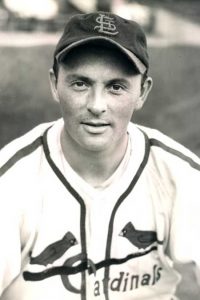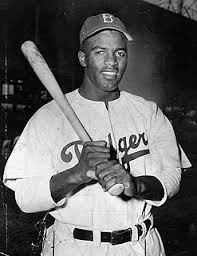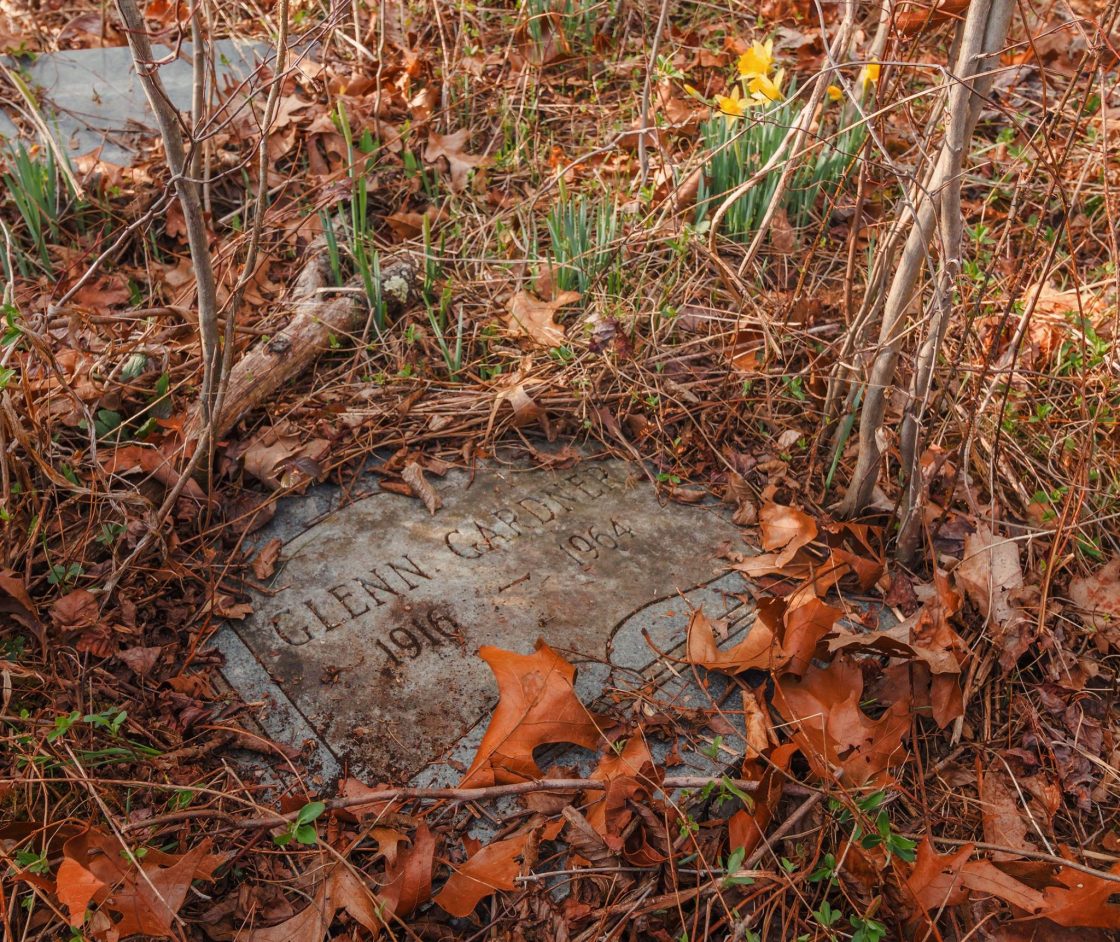“I think that’s it!” I exclaimed in hope to my friend Von Anglin as we were almost to the top of a ridge near his home in the Price’s Creek community of Yancey County, North Carolina.
“You think so?” Von replied in a tone wondering why I would think we had reached our destination.
“See all those daffodils at the top of the ridge?” I asked. I continued in elaboration “I learned a long time ago that when you see a bunch of daffodils together like that, you are usually at an old home place, cemetery or other place of significant importance to the old timers.”
 It had been unusually warm for the month of February, which had prompted the patch of daffodils to display an early full bloom. Von and I had swapped baseball stories as we walked up the ridge, our breaths coming with quick intakes in response to the steep terrain. He told me about the baseball talent of his late father, Vonno Anglin, who had played semi-pro baseball in the 1950’s and 1960’s.
It had been unusually warm for the month of February, which had prompted the patch of daffodils to display an early full bloom. Von and I had swapped baseball stories as we walked up the ridge, our breaths coming with quick intakes in response to the steep terrain. He told me about the baseball talent of his late father, Vonno Anglin, who had played semi-pro baseball in the 1950’s and 1960’s.
In a twist of irony, Von and his sister, Cynthia, had inherited property from their father that adjoined an old cemetery which very well could be the mystery cemetery I was looking for and fit the general locations found on the internet.
When we arrived at a rusty barbed wire fence I couldn’t help but smile.
“Yup. This is it” I said as I viewed a headstone less than fifty feet away, hoping in my heart that this was the correct cemetery.
The barbed wire was bowed with a wide opening, inviting us inside the cemetery, which appeared to have not been cleaned off in at least ten years, an observation of which Von noted.
When we arrived at that aforementioned stone, I became excited when I saw the inscription:
Miles C. Gardner
1881-1967
That gentleman, better known as Conner Gardner, had been the father of the individual I was looking for. We had hit pay dirt, so to speak.
We combed through the overgrown plot, going from stone to stone to no avail.
I came across two gray semi-flat stones, side by side, each unmarked.
“How odd is that” I asked Von.
“That is odd” he concurred.
However, I still hadn’t found the stone I was looking for. We searched around in frustration as the evening sun was sinking low.
I walked over to the edge of the fence, admiring the incredibly pastoral view of Banks Creek below while I calculated in my mind. I couldn’t help but smile to myself at the irony that there were only nine marked graves in this cemetery, just like position players on a baseball diamond. The graves were even placed in a rough representation of nine baseball players.
Out of sheer gut instinct, I walked back to the two unmarked stones.
‘The male is usually buried on the left’ I silently reminded myself as I walked on the grave.
Then I felt something solid underneath my feet. I used the brown Ariat boot on my right foot to brush away the leaves and dead grass. As I did so, what I had been looking for months for revealed itself to me.
=============
JULY 21, 1945
 World War Two was still raging on in the Pacific Theater, despite Allied Forces victory over Germany and Italy the year before.
World War Two was still raging on in the Pacific Theater, despite Allied Forces victory over Germany and Italy the year before.
The world had no way of knowing it, but it would be but just another sixteen days until the most significant event of the Twentieth Century would take place; the world’s first atomic bomb would be dropped over the city of Hiroshima, Japan by a United States B-29 bomber called “The Enola Gay”.
In St. Louis, Missouri it was a steaming ninety six degrees with stifling humidity along the Mississippi River.
The hometown favorite St. Louis Cardinals were facing off against the Brooklyn Dodgers at Sportsman’s Park. For one rookie the excitement of making the Big Leagues surely overcame any oppressing heat and humidity of this scorching day.
Twenty-Nine year old Glenn Gardner from Yancey County, North Carolina had finally made it to the Majors after having spent ten long seasons in the Minor Leagues, first for the Chicago Cubs and then for the Cardinals after his 1941 trade. The five feet-eleven inch, one hundred-eighty pound right handed pitcher had been called up two days prior from the Rochester Red Wings of the International League. Gardner was a replacement player, filling in while Cardinal regulars fought in the war.
Gardner would spend 1.2 innings in relief on this Saturday day game. To be honest, it was a fairly rough outing for Gardner in his first appearance.
He would give up two walks, five hits and two earned runs with an ERA of 6.00.
Luckily, the Cardinals would beat the Dodgers by a score of 8-7.
However, Gardner would go on to pitch in the Majors for another glorious two and one half months in 1945, mostly in relief but he would get four starts as a pitcher.
He performed very well, finishing with a 3 win, 1 loss record, 1 save, a very respectable ERA of 3.29 and at the plate would go 7-21, creating an outstanding .333 Batting Average.
But for Gardner and the Cardinals, 1945 would not wind up being their year. Despite going 95-59, the Cardinals would finish three games behind the red hot Chicago Cubs in the pennant race. The Cubs would go on to lose the World Series to my beloved Detroit Tigers.
============
1946
 Despite having a short but successful rookie campaign the year before, Glenn Gardner found himself back in Rochester assigned to play for the Red Wings yet again.
Despite having a short but successful rookie campaign the year before, Glenn Gardner found himself back in Rochester assigned to play for the Red Wings yet again.
The frustration must have been overwhelming but he was loved in Rochester, nicknamed “The G-Man” by teammates and fans.
He had no way of knowing it at the time, but he was about to play a small role with major American Historical and Social impact, participating in the very early stages of the Civil Rights Movement and probably the greatest sports story of the Twentieth Century.
You see, Rochester is in Minor League Baseball’s International League. So were the now defunct Montreal Royals, a Minor League affiliate of the Brooklyn Dodgers.
One Montreal rookie was part of a great social and sports experiment by the Brooklyn Dodgers President and General Manager, Mr. Branch Rickey. That experiment would break up Major League Baseball’s color barrier, bringing integration to professional sports.
That Montreal Royal rookie was none other than the one and only Jackie Robinson of course. Robinson would lead the Royals to the 1946 Governor’s Cup Championship and then become the first African-American to play Major League Baseball in over fifty-eight years, playing second base for the Brooklyn Dodgers.
Meanwhile, 1946 was horrendous for Gardner and the Red Wings. They finished seventh in the league, next to last with a 65-87 record. Statistically, Gardner and the Red Wings had the best pitching in the league but their hitting was horrible.
Ironically, the St. Louis Cardinals, Gardner’s team the year before would go on to win the 1946 World Series over Ted Williams and the Boston Red Sox when another North Carolinian, Enos Slaughter, would wind up making his infamous “Mad dash home”.
===========
1947-1952
Glenn Gardner would remain in the Minor Leagues for another six seasons, just trying to make a living in search of one more shot at the Majors. That chance would never come. By 1948, he was thirty-two years old. His arm was letting go and he was demoted down after the season. He continued this downward professional spiral, spending his final season in 1952 with the D Class Lockport Locks of the New York Penn League.
He had spent a total of seventeen grueling seasons in the Minor Leagues, two and one half months in the Majors.
=============
July 7, 1964
Miles Glenn Gardner died at just forty-eight years old in Rochester, New York. His life had been shortened by the heartache of not fully attaining his dream; his hard work and talent had not been enough. The bitterness caused by the latter led Gardner to shorten his life by his own hand. After retiring from baseball, Gardner became a bartender in Rochester. He couldn’t or wouldn’t come home a self-defined failure.
Miles Glenn Gardner had died of Liver Cirrhosis as a result of having become an alcoholic.
His body was cremated, which was more a sign of poverty in 1964 and not necessarily a personal choice.
Adding to the tragedy was a letter addressed to Major League Baseball by Gardner’s widow, Elizabeth Kate Gardner. Much like a Civil War widow from a century before, she inquired about a Widows Pension, stating that she “sure could use the money.”
There was no pension.
==========
February 23, 2018
I looked down at the flat stone. Inside of a carved Holy Bible outline was the simple inscription:
Miles Gardner
1916-1964
Distinct sorrow at the finality of it all flooded my heart in place of any glib satisfaction, the latter of which would have been the norm.
I had done so much research on the subject that I was sick of research, which is saying something. I’d even contacted the Rochester Red Wings Director of Media Relations, Nate Rowan, seeking out Glenn Gardner statistics, particularly one on one matchups vs. Jackie Robinson.
None existed, just Gardner’s basic yearly stats from 1942-1948.
In addition and to his credit, after exhaustive research I can find no evidence that Gardner was one of the individuals who had hurled racial taunts and insults at Robinson.
Jackie Robinson died in 1972, eight years after Glenn Gardner. Like Gardner, Robinson had died all too young at the age of fifty-three, diabetes and the stress of his endurance catching up to him.
Glenn Gardner death was in part due to not being given a second chance.
Jackie Robinson death was in part due to being given a first chance.
I am of the opinion that by the time Glenn Gardner and Jackie Robinson hung up their spikes they had given their all to baseball but not before those spikes had already fatally pierced their hearts.
Y’all have a great week!

